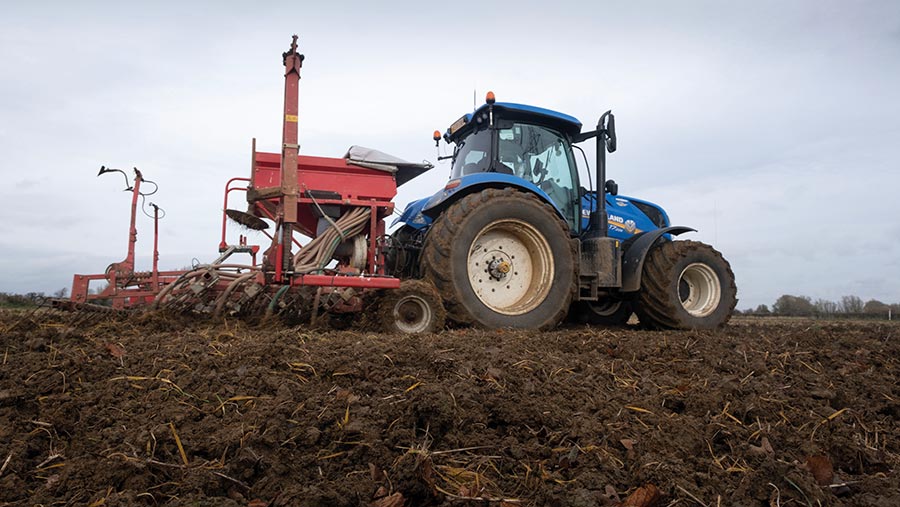How growers can help secure future of bentazone with web tool
 © Tim Scrivener
© Tim Scrivener A new tool has been introduced to help growers reduce the risk of water pollution and the loss of a vital post-emergence herbicide for pulses and potatoes.
Bentazone is a key post-emergence herbicide, especially for beans because it is the only approved post-emergence option.
But the active is being found in groundwater and there is a risk that growers could face future restrictions or even see it banned.
To help maintain bentazone’s approval beyond 2025, leading manufacturers BASF, Nufarm and Sharda Cropchem formed the “Know the Bentazone Risk” initiative, which this autumn sees the launch of the Bentazone High Risk Mapping and Planning Tool.
This interactive web tool enables farmers to identify if they are in a high-risk area with a postcode search.
See also: 5 cultivation and establishment methods compared
The tool takes the high-risk criteria from the stewardship guidance – soil depth, underlying soil/bedrock, organic matter and depth to groundwater, combined with Safeguard and Source Protection Zones – to quickly and easily show the bentazone risk to water across the country.
The aim is to help growers who may use the herbicide on crops such as peas, beans, potatoes, leeks and onions plan now to avoid needing to apply bentazone in a high-risk area.
As harvest concludes and the challenging weather is on many growers’ minds, selecting locations this autumn that have reduced chances of leaching, strong soil organic matter and operate with a 6m buffer zone/5m no spray zone, will help contribute to a strong stewardship programme.
Paul Goddard, stewardship and value chain manager at BASF, commented on the development:
“By speaking to growers over the past year, it is clear we needed one tool that collated maps and information available, to support decisions when it comes to planning the rotation and reducing water pollution.
“Through a simple colour coding, it will identify if applying bentazone to a certain field would not meet stewardship guidance, or if the field should meet certain soil thickness and organic carbon parameters.”
Water risk
Bentazone has been identified from official monitoring as the herbicide most frequent to exceed the Drinking Water standard in groundwater and is increasingly found in surface water. This is also the case in Europe.
All formulations of bentazone have the potential to be found in water and stewardship guidance applies to them all. Authorisation for bentazone products in Europe could be restricted or lost unless care is taken to protect water.
Bentazone is extremely soluble and can be highly mobile through soil. Even in the drier months, this combination results in bentazone appearing in water.
Leaching to groundwater is more likely on vulnerable soils. Surface water may be reached via drain flow, surface run off or spray drift.
Growers should know if their fields are on vulnerable soils and treat them following this stewardship guidance:
Guidance for bentazone use in high-risk fields and all other areas |
|||
|
Responsible use of bentazone |
High-risk areas* |
All other areas |
|
|
Soils |
Shallow,** stony soils*** over chalk or limestone** |
Do not use |
Avoid use |
|
|
Shallow** soils over sand or gritstone |
Do not use |
Avoid use |
|
With shallow groundwater |
Do not use |
Avoid use |
|
|
|
With very low organic carbon |
Do not use |
Avoid use |
|
|
Other soils |
OK to use |
OK to use |
|
Timing |
Spring and summer |
OK after 1 April |
OK to use |
|
|
Autumn and winter |
Do not use |
Do not use |
|
Rate |
All soils |
Do not use >1,000g/ha of active |
Avoid using >1,000g/ha of active |
* Drinking Water Groundwater Safeguard Zones for bentazone or nitrate, Groundwater Source Protection Zones 1+2 (see gov.uk “check for zones” and for groundwater source protection zones 1+2 see Natural England “Magic Map“)
**Shallow, stony soils have a low maximum ploughing depth (<30-35 cm).
***High stone content (>1 cm) in top soil and at the soil surface (>10% of surface area). These soils also tend to have a high pH (>7).
Soils with shallow groundwater are those where ground water occurs <1m below soil surface for at least part of the year. These soils are generally located in river valleys and lowlands.
For some of these soils, groundwater level may lead to limited opportunities to use heavy machinery.

